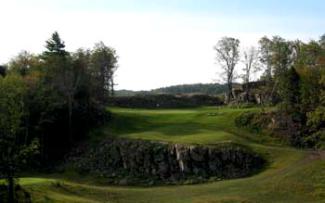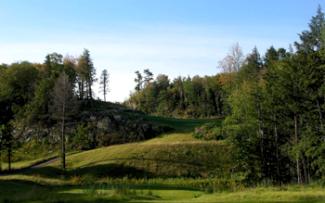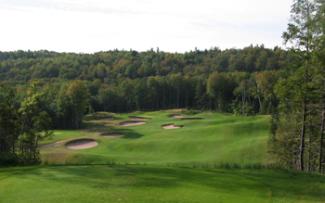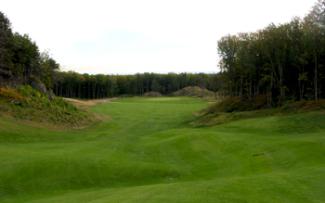Featured Golf News
Toning It Down Makes Difference at Greywalls GC
It's truly a blessing when a course architect finds a piece of land with so many potential "highlight" features that some of them need to be toned down to bring the golf element into better focus. Such was the case with Mike DeVries and Greywalls, his course in the Michigan Upper Peninsula town of Marquette and the second of two tracks at the town's eponymous golf club.

The 6th Green at Greywalls Is in a Natural Rock Bowl.
Greywalls, which rolls down steep hills and jagged rock to a verdant valley and wetlands, was built in 2005 and quickly became the featured venue at Marquette Golf Club, which opened in 1926 with the Heritage course and is now the only 36-hole facility in the UP.
The site's natural terrain and massive rock outcroppings gave DeVries - who worked with Tom Doak and was once the groundskeeper at the fine Crystal Downs Country Club downstate - a stage unique in Michigan. Here there are far-reaching vistas of Lake Superior, and even the Pictured Rocks National Lakeshore some 55 miles into the largest of the Great Lakes.
DeVries would readily acknowledge that the wonders of Greywalls' site had less to do with him and more with Mother Nature. But DeVries' handiwork should be lauded and enjoyed. He had 233 acres at his disposal, but much of that was not usable due to wetlands, a trout stream, ledges and sheer rock walls.

Greywalls
These restrictions dictated the routing, which begins on high ground and moves into a rocky transition before heading back to the upper plateau for three holes. Down in the valley for hole Nos. 11-14, DeVries brings most of the course's 36 bunkers into play, and the layout ends by heading back into the rocks before closing with a pair of holes that seem simple but demand precision.
"The difficulty was in finding good golf holes that fit together and produced a rhythm and flow to the course," DeVries said. "It was a challenge to not make it too dramatic and to keep the players' focus because of the rock everywhere and views of Lake Superior. I wanted to make sure it was good, solid golf, not just a few holes that really gave golfers a 'wow' factor."
During construction DeVries moved just 40,000 cubic yards of dirt and blasted only 3,000 cubic yards of rock on a course that provides a nice mix of vistas, features and strategy.

From the Fifth Tee at Greywalls
Up & Down We Go
Greywalls plays just 6,828 yards from its back set of four tees, where it carries a rating of 73.0 and Slope of 144. The track's hardest holes are three of its two-shotters: the 425-yard second, 489-yard seventh and 491-yard 12th; the 240-yard par-3 15th is surely as testy as the 449-yard 14th.
After a lengthy golf cart ride from the parking lot and Marquette Golf Club's rather pedestrian clubhouse, the view from Greywalls' first tee sets the stage for the experience ahead. The tee is at one of the highest points on the property (from here the Pictured Rocks can sometimes be seen) and the hole, a 579-yard par-5, tumbles over a ravine to a rolling landing area. The elevated green may be attacked in two, but having an uneven fairway lie and facing a target ringed by plenty of penalties should temper such notions.

Lake Superior on View at Greywalls' 9th Hole
The second hole rises slightly off the tee and onto an undulating fairway that ends in a ravine. Its green, which slopes hard left to right and back to front, makes this hole difficult; when the cup is cut on the left, it's nearly impossible to get a second shot close.
Much is made of the transition holes (Nos. 4-7) at Greywalls, but three of the four are really great and call for care off the tee and (at Nos. 5 and 7) on the approach. The fifth (a 312-yard par-4) plays uphill over a rock wall to a narrow path, then to a rolling green wedged between an outcropping and a tall rock wall.
The 188-yard par-3 sixth also plays uphill and its green is in a natural bowl defined by rock on three sides. "The site for the green was a bit extreme but it captured the flair and tenor of the entire property," DeVries said. "It's rugged, but it's just reflective of the course and makes for a great hole."

Bunkers at the Dangerous, Downhill 11th at Greywalls
No. 7 is a monster, moving downhill and over a rocky ledge to a chute of fairway that runs along the left side of a protruding rock. From either spot, the green (one of the largest here) can be attacked, but the approach is likely to be from a downhill lie to the slightly elevated putting surface.
DeVries uses a wide, uphill slope to get the golfer from the 10th green to the 11th fairway, but it is on the latter (a 388-yard par-4) where he brings bunkers into play for essentially the first time. Eight of the course's three dozen sand hazards are found on this hole, a situation that turns an innocuous and relatively short two-shotter into a stern test.
The 491-yard par-4 12th is wide open off the tee, but shots short of the back-to-front-sloping green will find one of the two bunkers that prevent run-up shots. The 559-yard par-5 13th has 10 more bunkers and is a true three-shotter thanks to trees that pinch the fairway's left side, its large, wildly pitched putting surface and those bunkers.

The Par-5 18th Tempts Players to
Try for the Green in Two
No. 16, a par-4 of just 370 yards, is not long on distance but asks for supreme commitment. Mounding along the right and a wetlands left narrow the landing area, and the 16th's very large (a square-shaped homage to Donald Ross) green has a gentle front-to-back tilt that seems to repel even short-iron approaches.
The round at Greywalls ends with two holes where a golfer can score with accuracy and verve. The 17th, a tiny 137-yarder, must be attacked to the correct section of its three-segmented putting surface.
The closer is a 533-yard par-5 that plays off an elevated tee over a mound to a mere 22-yard-wide fairway. If the player reaches the short grass, he can make a hearty swing at the green in two, which is defenseless, save for a large knob in the middle of the putting surface that pushes shots to one side or the other. DeVries likens the final two holes as the "calm, flat areas during the final stretch of a rollercoaster ride."
Golfweek named Greywalls the No. 2 golf course you can play in Michigan in 2010, the very year it was ranked No. 79 by the same magazine on a list of America's best modern courses. Golf Digest has ranked Greywalls as the 23rd best course in the Wolverine State.
Some golfers feel the course has a bit of a Scottish feel, and when the wind whips off the nearby huge lake it certainly bears that trait. Because of the many outcroppings bordering and within some fairways, this a demanding course off the tee. But if a player can stay in these well-groomed corridors, Greywalls is infinitely playable.
For more information, visit http://marquettegolfclub.com/course_grey.
Steve Habel is one of Cybergolf's world correspondents, contributing news stories, features, equipment and book reviews and personality profiles from his base in Central Texas. He is also works as a contributing editor for Horns Illustrated magazine, a publication focusing on University of Texas sports, covers the Longhorns for CBS Sports, is regional editor for Texas Golfer magazine and files stories for Golf Oklahoma magazine, Texas Links magazines and Golfers Guide. Habel's main blog (www.shotoverthegreen.blogspot.com) features news on golf and the Longhorns, and another (www.checkinginandplayingthrough.blogspot.com)chronicles his many travels, on which he has played more than 350 golf courses since 2009. Habel is a member of the Golf Writers Association of America and the Texas Golf Writers Association.
Story Options
 |
Print this Story |
